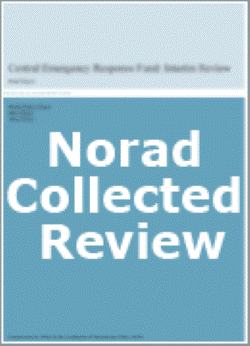End Review of Zambia Axle Load Control Programme
Om publikasjonen
- Utgitt: november 2009
- Serie: Norad-innsamlede rapporter
- Type: --
- Utført av: Gicon AS, Norway in association with InfraAfrica (Pty) Ltd, Botswana
- Bestilt av: Norad and Ministry of Works and Supply, Zambia Road Development Agency
- Land: Zambia
- Tema: Handel og transport
- Antall sider: 62
- Serienummer: 15/2009
- ISBN: 978-82-7548-447-3
- ISSN: --
- Prosjektnummer: Zam 3015

The Project
The Axle Load Control Programme for Zambia was launched in April 2004, with a budget of
NOK 50 million (USD 7.2 mill), NOK 30 mill from Norway and € 2.5 mill (approx. NOK 20 mill) from
the European Commission (EC). The programme budget consisted of an investment component of USD 4.3 mill and a Technical Assistance (TA) component budgeted to USD 2.9 mill. The Norwegian TA is regulated through the Agreement between the Ministry of Works and Supply and the Norwegian Public Roads Administration (NPRA) of November 2003, with an Addendum of June 2004.
One of the key features of the programme is its holistic and integrated nature which seeks to address the issue of overloading in a comprehensive manner. This approach avoids the pitfalls suffered in other countries which have attempted to address overload control in a piecemeal manner over an extended period of time.
Interesting Findings
- The programme was structured into ten components. On an overall assessment of the components (four scales rating), one (Weighbridge Equipment and Sites) was rated as very unsatisfactory, due mainly to the delay and overrun of costs; one component (Project Monitoring) was rated as unsatisfactory; six components were rated as satisfactory; and one (Improve Organization and Procedures) was rated as very satisfactory. One component (Commercialization/privatization of Weighbridges) has not yet started.
- Technical assistance to the programme was commissioned through an agreement between the Zambian Roads Department and NPRA signed in December 2003. The agreement provides a framework for an institutional cooperation between the Road Development Agency (RDA) and the Norwegian Public Roads Administration (NPRA). The review found that the technical assistance from NPRA was an essential input to the ALCP. The input to the project from NPRA in the form of one long term advisor and 11 short term advisors represented in total about 529 person-weeks or about 12 person years over a period of five years and three months. The total cost to the Project for NPRA’s services was about NOK 12.3 million, or about 25% of total project cost of NOK 50 million. There have been long delays of unsettled payments to NPRA which pose a threat to good relations between NPRA and RDA. It is therefore recommended that RDA should pursue measures to ensure that NPRA is paid timeously, as per the agreement between the two organisations.
- Based on the overall results achieved for the Project and the excellent working relations with the RDA, the institutional cooperation component has been judged as effective. There was a considerable over-expenditure compared to plans as the need for advisors increased. It has been rated as 3 out of 4, i.e. satisfactory.
- Anti-corruption measures are built into the Project and are continuous and of a general nature. Anecdotal evidence suggests that corruption has been reduced since the Project started in 2004. A general reduction in the overloading is at the same time a good indicator of less corruption at the weighbridges. The extent of overloading is monitored through the records from the fixed weighbridges and the mobile spot checks and appears to have been reduced considerably.
- The issue of gender equality was not included as a separate component of the Project with its own budget. As a consequence the issue has not been reported on separately to the management or donors. The Project management has however recognized that employing women in the project, and especially at the weighbridges, may as a side-effect contribute to reducing corruption. The management reportedly is of the opinion that women might be less prone to corruption. And their experience from recent postings shows that women at the portable weighbridges have no particular problem in handling truck drivers.
- Even before the full complement of weighbridges has been installed, a significant reduction inoverloading has been achieved. Thus, it is recommended that careful consideration needs to be given to the costs and benefits from the planned substantial investment in fixed weighbridges.
- It appears likely that future funding of weighbridge operations can be provided from the Road Fund on a sustainable basis. However, based on the government’s somewhat erratic funding of weighbridge operations in the past, the issue of future finding for the programme must be an area of concern. It is recommended that RDA should work out a plan for future financing of weighbridge operations.
